
|

|
|
| Karlheinz Essl | Jack Hauser |
Improvisation on "Improvisation"
2002

|

|
|
| Karlheinz Essl | Jack Hauser |
Improvisation with Computers
Karlheinz Essl improvising with his realtime composition environment m@ze°2 |
On February 21st, 2002 the performance artist and ex-filmmaker Jack Hauser visisted the composer and improviser Karlheinz Essl in his studio. This encounter should help to overcome a "writing block" which had been bothering the composer for some time, and for several months kept him from committing to paper a text in which he should explain his position regarding improvisation. In order to enable the composer to approach the subject, it was agreed to have a spontaneous informal conversation - a free improvisation on the topic of "improvisation", so to speak, - which later should serve as source material for a theoretical text. The conversation was recorded and transcribed.
Jack Hauser: I'm interested in seeing composition and improvisation as two methods of making music, finding movement material or making conscious atmosphere and space, rather than regarding them as opposites. It is possible to achieve this in different ways. The compositional method consists of imagining something, building structures, and then writing them down in a score. The improvisational method, however, tries to create complexity in the moment without writing, by manipulating all kinds of parameters which are also available in composition. My question to you is whether you have an idea how to describe this method?
Karlheinz Essl: The significant difference between composition and improvisation is their different dealing with time. In composition you are in a way outside time, abstracting therefrom; one tries to imagine the whole process and can zero in on time microscopically - stop it, so to speak. In composition you simulate a time structure that - converted into reality - lets the actual piece come into being. But improvisation is completely different: you are inside time in the moment, form time and its passing in "real time"; and now, within this mercilessly passing time frame you have to follow a certain way which maybe you've thought about before or which turns out to be negotiable during the improvisation, and at the same time be continuously conscious of references: what's happened before, how can I go on working with this. This is no senseless continuous going forward, but the intentional visiting of previously existing conditions in order to further transform them. Again and again building bridges to the past. I think this is very important: that time goes forward, but in improvisation again and again one tries consciously to recur to that which was, so as to create points of reference.
JH: This is concurrent with my experience. The longer you've been dealing with improvisation, the better you know about it. So a kind of memory forms, and you're not subject to "merciless time" any more (that's what it sometimes feels like in the beginning), but you get a feeling of lots of time ...in this time, you can retain an aspect of writing - as if you yourself were part of the composition.
KHE: I believe that this is an important thought. By visiting situations that have happened before, a discursive element enters the improvisation which actually is an integral part of composition. Through this, something happens which I usually label with the somewhat sloppy term "real-time composition", where improvisational principles are strongly fed by structural concepts derived from composition: 1) the structural work with meta-concepts developed beforehand, and 2) the creation of variants, where entirely different viewpoints are distilled from a basic model. In improvisation, this is brought into a chronological sequence in which premonitions and references are possible. And this distinguishes improvisation as we understand it from another approach that is found e.g. in traditional jazz music: where predefined circular form models are visited and played with in a virtuoso way.
Another aspect comes in here: there is a significant difference between improvising alone, as a duet or as a collective.
JH: Monologue - dialogue - collective...
KHE: The variety of "real-time composition" we've just mentioned is good to apply to a solo improvisation. Although in the course of time I had to learn how important it is to be prepared. In the beginning I was very excited about having everything at my command. However, when hearing the recordings later I rarely was contented with them because they didn't have the quality of compositions.
JH: What expectations does one have from oneself as an improviser? If you believe to be able to write the "Odyssey" by throwing dice, you're lost from the outset. But with improvisation you want to go elsewhere, towards another aesthetic or message, musically or performatively. Still, there's something like personal taste. How strongly does the compositional work affect the improvisational concept? Where does one want to go with improvisation? Why does one choose improvisation instead of composition?
KHE: In this connection, I often talk about the magic of the moment. Because in improvisation, unlike composition, one is not "out of time" but in the middle of the passage of time, situations come up due to this responsibility and this compulsion that cannot be planned by a composer at the writing-table. That's why I'm interested in improvisation: because there I can arrive at formulations which would never come to me at the desk. Even if I improvise solo and have prepared certain material and structural concepts, in the moment of playing, and in continuous contact with the sound created, the necessity of a progression will come up which I could never realise in customary composition.

|

|
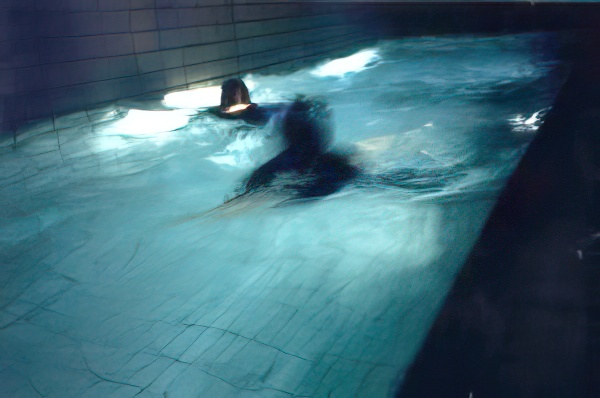
|
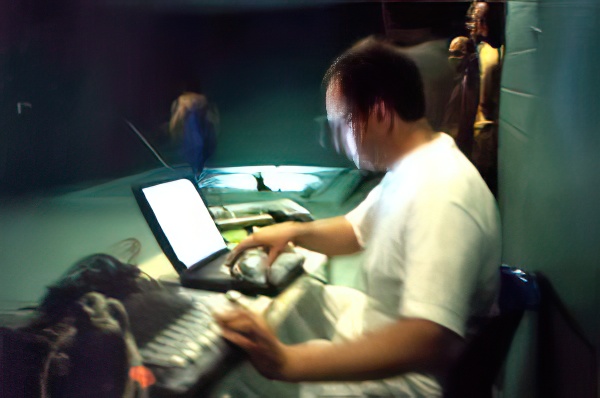
|
fLÜSTERN
(Sargfabrik Vienna, 1999)
featuring Karlheinz Essl (computer, electronics), Elisabeth Flunger (percussion)
in collaboration with LUX FLUX (Inge Kaindlstorfer, Annette Pfefferkorn, Jack Hauser, David Ender)
Photos by Oleg Soulimenko
JH: Does improvisation imply a social necessity for you because the changed living conditions require something like that? Or does it come from purely aesthetic considerations on your part?
KHE: I believe that improvisation also offers another approach for the audience. Instead of presenting a finished product I've wrested from myself in week-long work, I now invite the audience to become witness of a process.
JH: Meaning that the monologue itself is a dialogue already...
KHE: A dialogue with the audience. - I felt this instinctively when I began as an improviser. I always played in front of an audience, always public. In 1998, when I played with Christian Fennesz in "rhiz" for the first time, we didn't even know each other. It was then when I noticed that the public has an eroticism that really makes demands on you and puts you into tension. For instance, I'd find it completely uninteresting to improvise now together with you here in my studio. But I'd find it terribly exciting to do this during the opening times of the museum (the Essl Collection) even if it hadn't been announced as a concert.
JH: Although you certainly prepare yourself. Not only mentally but practically, too. Without an audience.
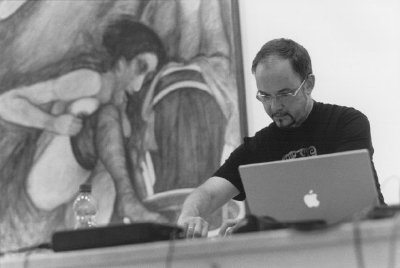
Karlheinz Essl während einer Solo-Performance
an seinem Instrument m@ze°2
Photo © 2004 by Didi Sattmann
But preparations are entirely different if one improvises with one or more other people. I have a section which I call "blind dates": the first meeting with another musician - without any rehearsal. Here, I've made the experience that it's not so important to rehearse together, but rather that one gets acquainted with each other on an altogether different level, as persons: by talking, going for a walk, bicycling, or eating together. An approximation on the human level which builds connections and bridges between two strangers, and which can be passed (and trespassed!) during the improvisation. One doesn't know the other person as a musician yet, but as a person, and has developed certain feelings and seen possible approaches which can help in the joint improvisation. There is trust...
JH: You're saying something important there: that an extra-artistic moment is necessary for improvisation. Feelings, for example.
KHE: But with my "blind dates" I also had experiences with people who weren't very likeable to me personally, who maybe seemed a little arrogant or highbrow to me, or who brought their strong personality into play in a dominant way. But still interesting things came out of this.
JH: This aspect also makes improvisation so exciting for me, because you can fail utterly - before an audience! You've got to learn to deal with that. But one the positive side there's also the joint negotiation of areas one has never been to before. This, then, is not experienced as failing - moreover, it eludes any kind of analysis because there is no point of reference yet.
To me, another important thing in improvisation seems its influence of serialism.
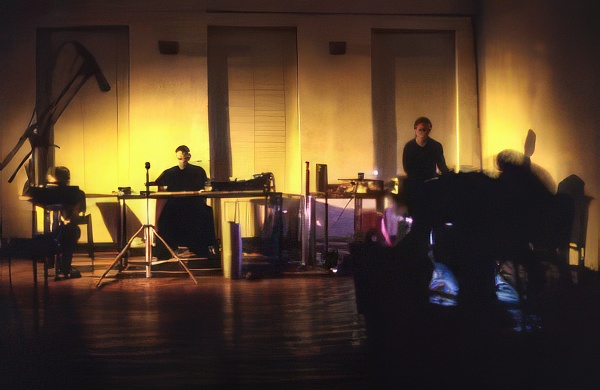
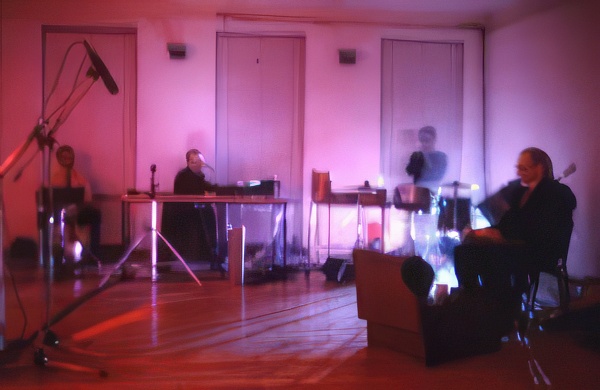
fLIGHT (Echoraum Vienna, 1998)
featuring Karlheinz Essl (computer), Jack Hauser (cümbüs, theremin), David Ender
(Schreberinstrumente), Elisabeth Flunger (Percussion), Peter Panay (e-git, devices)
Photos by Werner Korn
JH: It went completely different with us than it did with you. In the beginning that which you call "blind dates" was at the centre. But in the course of time, a great danger resulted from this, because we repeated ourselves in a way that we weren't contented with the results any more, and something came into play which again stood at the beginning for you: the realisation that we needed to have more structures at our command than the ones that come to us spontaneously in the moment when we are pressed for time in front of an audience. Because of this we only developed soap operas at that time, with ever-similar affinities between persons. I believe that the process is the same in musical improvisation, that under pressure you rely on something that worked some other time, and of which you believe that it still works. As if one hoped to create the "Odyssey" by throwing dice: you believe that you only have to throw often enough. But the treasure of improvisation lies somewhere entirely different, and there are numerous methods to salvage it. Our latest works appear completely structured throughout - although we improvise much more than we did, as there are more options to choose from. That's the point exactly: one is freer and can go into the future more easily the more possibilities there are.
KHE: But these options have to be prepared beforehand.
JH: Yes, you have to have them consciously available in order to be able to choose in the moment. But during an improvisation it may happen that you confine yourself to minimal material although you have prepared a much broader spectrum. After all, the danger of improvisation as well as of composition is in the belief that one has to show everything.
KHE: That's something I had to learn. The realisation that concentrating on a certain material is very important. This reminds me of John Cage who - bluntly expressed - couldn't care less about accident. He didn't give a shit but merely took advantage of random numbers which the I Ching (and later a computer program) supplied. Meanwhile, thanks to the basic research of Gottfried Michael Koenig, we know that there are different kinds of randomness: the randomness of the dice, the randomness of the pack of cards (with implemented repeating prohibition), weighted randomness etc. Cage, however, actually always uses randomness trivially; only what he applies it to is nothing less than trivial. For Cage always asks questions first, and these actually are his material. He determines certain constellations and possibilities, and accident is then used to bring that material into a non-intended sequence. But the material itself is prepared and well thought out.
JH: That's the point exactly! Important with regard to improvisation is the material one has prepared beforehand.

Yoo Doo Right
(Sammlung Essl, Klosterneuburg 2002)
featuring Elisabeth Flunger (drums), David Ender (bass), Karlheinz Essl
(computer), Jack Hauser (vocals), Peter Panay (e-git, devices)
Photo: Gaby Bösch
KHE: In the moment of the performance, the "accidentalness" of the encounter creates a necessity for putting together certain material. If you approach the thing with the help of various material preconditions, something else will come up than if you let it simply happen through "laissez faire". This is a basic realisation I owe to John Cage, and which many people don't understand because they believe that throwing the dice alone will suffice. But in the first instance it's about the questions one asks: concerning the situation, the material. These, however, are intentions! Unintended are the intertwinement and the sequence and the respective encounter. Basically, this is nothing else but a continuation of permutation principles - whose roots reach back to times long past; long before Athanasius Kircher. You have e.g. a certain number of letters, and by combination or random...
JH: Now we're back to serialism!
KHE: It's all interconnected! Borges' idea of the "library of Babel", where through the combination of all the letters of the alphabet everything that has or hasn't been written is created. But it's about those letters: these you have to define in the first instance - for the respective improvisational concept...
JH: ...and one always has to make a decision. It doesn't help if I say that I want possibilities and that I won't make a decision now because everything is there anyway. Then, nothing will be created.

fLOWER (Minoritenkirche Stein 2000)
featuring Anne LaBerge (flute, electronics), Karlheinz Essl (computer, soundscape,
electronics), Elisabeth Flunger (percussion), Didi Bruckmayr (vocals), Martin Siewert
(e-git, electronics), Arne Deforce (electric cello, electronics)
JH: Do you see this crisis as a purely artistic one, or is there the danger of offending or compromising someone personally - in a situation, where everyone depends on each other?
KHE: For me it's about the personal thing. We are in a very sensitive area here - yoked together in a relational structure where we all are quite unprotected and vulnerable. That makes it easy to keep up a condition of mutual contentedness and comfort. That can be very nice but also dangerous because everything becomes petrified in it. It takes on an air of self-complacency. Instead of keeping up conditions like this for a longer period, I'm more interested in permanently transforming them. But this may present an effrontery for the other. Nevertheless, I keep doing it - and I also "warn" my co-musicians that I employ those means now and again. Because it's just these crisis-laden situations of conflict which create a powerful potential out of which so much more can happen. It may go to pieces, but it also may develop in an exciting way. It's especially dangerous when within an abstract musical context that hardly takes recourse to familiar expression, suddenly concrete, recognisable material is brought into play which also carries a certain anecdotal moment. If e.g. you're working with musicians who consciously place themselves outside any idiomatic context - and suddenly you confront them with a drumloop which doesn't fit into this context at all. How do they react to this "disturbance"? That's what I find extremely exciting.
JH: But this contains another great danger, because it easily becomes a recognisable method - a procedure creating a certain uneasiness. One forces somebody to a predictable reaction - and thus remains caught in a certain aesthetic. So, one again creates situations that are very similar to each other even if one has the intention of avoiding such a thing.
KHE: I do not employ this "alien" material as an affirmative gesture, but at the same time try to break open again that which threatens to make its appearance so complacently. For instance, I would start to successively crumble up and transform the drumloop mentioned as soon as it has been entered into the improvisational structure so that a new musical situation may eventually come up. That would be full utilisation of the difference in potential of an "abstract" musical language that doesn't suggest or allude to existing music, and a "concrete", trivial quote; a third way out of this conflict situation should be sought. So, the familiar "concrete" material immediately has to be transformed and eventually must dissolve in a new condition.
JH: We also have called this the "third" or "fourth" way. The "third" way is connected with dialectic, attempts the reconciliation of opposites in synthesis. With the "fourth" way, however we man a solution pointing in a completely different direction.
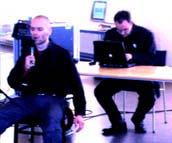
shots'n'shouts
Karlheinz Essl meets Didi Bruckmayr
Live at rhiz (Vienna, 7 May 2000)
Another model: the image of an atomic nucleus. All around it there's energy fields on which single individuals move like electrons. Every musician has a clear part there. This works especially well with "blind dates" if you know from the beginning who moves on which energy field. Everyone has his specific role. An improvisation like this would go a completely different way than one modelled to Brownian molecular movement.
Personally, I find the model of Maxwell's Demon the most beautiful: two connected receptacles in which hot and cold particles are separated. Of course, there is the natural tendency of the different energetic levels to assimilate. However, Maxwell's Demon sits at the connection between the two receptacles and tries to oppose the balance of entropy. It tries e.g. to keep faster atoms on one side in order to keep the energy level high there. In an improvisation, you can assume the part of Maxwell's Demon, and when you notice that everything levels out - as you described it before with "comfort" - attempt to bring meaning into the system.
These were only three examples. The more models you have available, the better you can react to different conditions.
KHE: For me, improvisation always is a mixture of the three models you've described so beautifully just now.
I would like to contribute another model: Game of Life. From a certain starting position unpredictable constellations develop in the course of time, which can take on certain patterns: pulsating fields that can be shot at and spatter apart. I've always been fascinated by this. In improvisation, too, I'm interested in continuously keeping the energetic levels variable. When all is said and done, it's about dynamics. I find nothing less interesting than remaining in a static condition. Although I have to admit that there is music or art...
JH: ...Minimal Art for example, where the dynamics are elsewhere - namely, in the listener's perception, too.
| Home | Works | Sounds | Bibliography | Concerts |
Updated: 2 Feb 2022